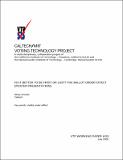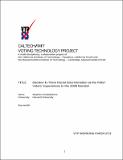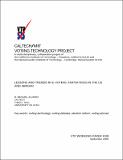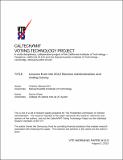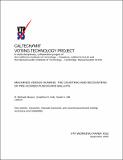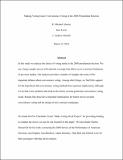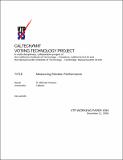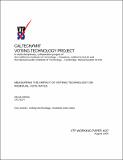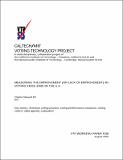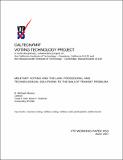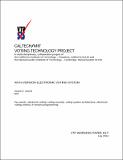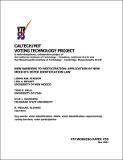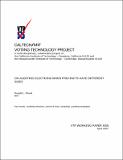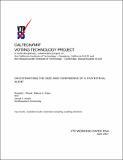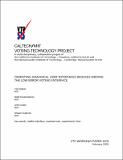Browsing Voting Technology Project by Title
Now showing items 44-63 of 125
-
Interstate Voter Registration Database Matching: The Oregon-Washington 2008 Pilot Project
(Caltech/MIT Voting Technology Project, 2009-08-10)Voter registration databases maintain lists of registered voters that are used to determine who is and is not eligible to vote in an election. As such, accurate voter registration databases form a cornerstone of the electoral ... -
The Introduction of Voter Registration and Its Effect on Turnout
(Caltech/MIT Voting Technology Project, 2004-02)Voter registration, it is widely argued, raises the costs of voting, thereby decreasing turnout. Studies of turnout across states find that states with later registration dates or election day registration have much higher ... -
Is It Better to be First or Last? The Ballot Order Effect
(Caltech/MIT Voting Technology Project, 2005-07) -
Is There Racial Discrimination at the Polls? Voters' Experience in the 2008 Election
(Caltech/MIT Voting Technology Project, 2009-03)In 1965, the United States Congress enacted the Voting Rights Act to end discrimination against black voters at the polls in Southern states and throughout the nation. The Act prohibited the use of “tests” and other devices ... -
Lessons and Trends in E-Voting: Initiatives in the U.S. and Abroad
(Caltech/MIT Voting Technology Project, 2005-09-01)Since the 2000 election, there has been a debate over the role of voting technology in the election process. In 2000 and 2001, this debate focused on the deficiencies associated with paper ballots—especially the punch ... -
Lessons from the 2012 Election Administration and Voting Survey
(Caltech/MIT Voting Technology Project, 2013-08-03)Since our country’s inception, collecting appropriate data on elections and the administration of elections has been somewhat problematic, due to the fact that multiple levels of government are involved in running elections ... -
Machines Versus Humans: The Counting and Recounting of Pre-Scored Punchcard Ballots
(Caltech/MIT Voting Technology Project, 2005-09-20)The counting of ballots, especially punchcard ballots, has received a great deal of attention in the years following the 2000 presidential election in Florida. Much of the research literature has focused on various measures ... -
Making Voting Easier: Convenience Voting in the 2008 Presidential Election
(Caltech/MIT Voting Technology Project, 2010-03-15)In this study we analyze the choice of voting mode in the 2008 presidential election. We use a large-sample survey with national coverage that allows us to overcome limitations of previous studies. Our analysis provides a ... -
Measuring Election Performance
(Caltech/MIT Voting Technology Project, 2009-12-11)The 2000 presidential election was one of the closest elections in American history. A margin of about 550,000 votes separated Al Gore from George Bush, only about 0.52% of votes cast. And despite the fact that Gore received ... -
Measuring the Effects of Voter Confidence on Political Participation: An Application to the 2006 Mexican Election
(Caltech/MIT Voting Technology Project, 2009-06-20)In this paper we study the causal effect of voter confidence on participation decisions in the 2006 Mexican Election. Previous research has shown that voter confidence was a relevant factor in explaining participation ... -
Measuring the Impact of Voting Technology on Residual Vote Rates
(Caltech/MIT Voting Technology Project, 2005-08)In the wake of the 2000 election, the importance of knowing the impact of voting equipment on the number of uncounted ballots became evident. Using data from the 1988-2004 presidential elections, this paper estimates the ... -
Measuring the Improvement (Or Lack of Improvement) in Voting Since 2000 in the U.S.
(Caltech/MIT Voting Technology Project, 2005-09-04)This paper summarizes what systematic evidence exists about the performance of the American voting process in 2004 and proposes a comprehensive system of performance measures that would allow citizens and officials to ... -
Military Voting and the Law: Procedural and Technological Solutions to the Ballot Transit Problem
(Caltech/MIT Voting Technology Project, 2007-03-08)During the 2000 presidential election controversy in Florida, the ballots submitted by individuals living overseas—especially military voters—were seen as crucial to the election outcome as the margin of potential victory ... -
Mobilizing Pasadena Democrats: Measuring the Effects of Partisan Campaign Contacts
(Caltech/MIT Voting Technology Project, 2008-06-28)This paper examines the effect of an entire campaign using a randomized field experiment here the treatment consists of campaign decisions made by a campaign manager. In contrast to the majority of the field experiments ... -
A Modular Voting Architecture ("Frogs")
(Caltech/MIT Voting Technology Project, 2001-08-18)We present a “modular voting architecture” in which “vote generation” is performed separately from “vote casting.” -
An N-Version Electronic Voting System
(Caltech/MIT Voting Technology Project, 2004-05-20)The ballot battles of the 2000 US Presidential Election clearly indicate that existing voting technologies and processes are not sufficient to guarantee that every eligible voter is granted their right to vote and implicitly ... -
New Barriers to Participation: Application of New Mexico's Voter Identification Law
(Caltech/MIT Voting Technology Project, 2007-11)In democratic societies there is a tension between maximizing ballot access and minimizing voter fraud. Since the 2000 presidential election, this tension has been central to discussions about election reform, at the ... -
On Auditing Elections When Precincts Have Different Sizes
(Caltech/MIT Voting Technology Project, 2007-04-29)We address the problem of auditing an election when precincts may have different sizes, and suggest methods for picking a sample of precincts to audit that takes precinct size into account. one method yields optimal auditing ... -
On Estimating the Size and Confidence of a Statistical Audit
(Caltech/MIT Voting Technology Project, 2007-04-22)We consider the problem of statistical sampling for auditing elections, and we develop a remarkably simple and easily-calculated upper bound for the sample size necessary for determining with probability at least c whether ... -
Orienting Graphical User Interfaces Reduces Errors: The Low Error Voting Interface
(Caltech/MIT Voting Technology Project, 2005-02)This paper demonstrates opportunities for reducing errors with orienting graphical interfaces for voting. We have built many interfaces to explore opportunities for keeping voters aware of selections they have made and are ...



